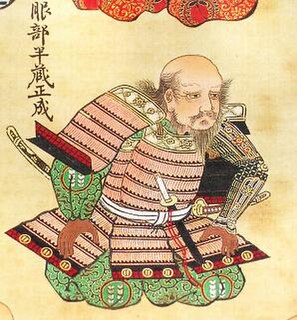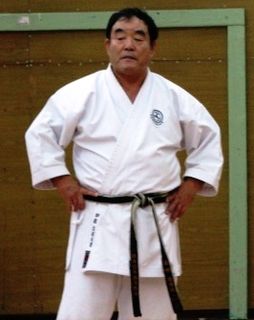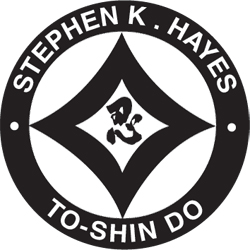Filmography
| | This section needs expansion. You can help by adding to it. (February 2017) |
- Ninja Vengeance (1988), Himself (as Ninjutsu Instructor) [24]
Stephen K. Hayes | |
|---|---|
| Born | September 9, 1949 Wilmington, Delaware, United States |
| Alma mater | Miami University |
| Occupation |
|
| Spouse(s) | Rumiko Urata Hayes [1] |
| Children | Daughters: Reina and Marissa [2] |
Stephen K. Hayes (born September 9, 1949) is an American martial artist and writer.
Stephen K. Hayes was born in Wilmington, Delaware, and raised in Dayton, Ohio. He graduated from Fairmont West High School in Kettering, Ohio, in 1967. [1]
Hayes attended Miami University in nearby Oxford, Ohio, because he "heard they had a judo club". [3] It turned out to be a Korean Tang Soo Do school, not judo, but Hayes remained. In 1971, he graduated from Miami with a Bachelor of Arts degree, having majored in speech and theatre. [4]
In the 1970s, Hayes traveled to Japan. [5] In June 1975, he met and began training under Tsunehisa Tanemura. He later trained under Masaaki Hatsumi, [6] who refers to himself as 34th Grandmaster of Togakure-ryū ninjutsu and is the founder of the Bujinkan (武神館) organization.
Hayes returned to the United States with his wife, Rumiko, in late 1980 when his Japan residency visa expired, and began teaching and authoring numerous books and magazine articles. [7]
In 1985, he was entered into the Black Belt magazine's Hall of Fame as Instructor of the Year. [8] He was again featured on the cover of Black Belt in the March 2007 issue. [9] [10] [11] The magazine's opening editorial described him as "one of the 10 most influential living martial artists in the world". [12]
In 1993, Hayes was awarded the judan (tenth-degree black belt) in Togakure-ryū ninjutsu from Hatsumi. [2]
In 1997, he founded the martial art of To-Shin Do, [13] an art based in his experience of budō taijutsu .
In 2006, Hayes's name was removed from the display of active Bujinkan teachers, ending his official role within that organization. That his name plank was removed from the Bujinkan Honbu wall has been documented by both parties. However, the specifics regarding the motivation for the removal are in dispute. Some suggest Hayes was expelled from the organization. [14] Hayes explains that he simply no longer participates as an active Bujinkan instructor. [15] To-Shin Do is taught through his SKH (Stephen K. Hayes) Quest locations. The SKH Quest network now spans 31 schools across North America, Europe, Australia and Africa. [16]
Hayes acted in the 1980 television miniseries Shogun [17] and in 2004 was featured in the Discovery Channel documentary Unsolved History regarding ninja and their practices. [18]
Hayes is an ordained practitioner of esoteric Tendai Mikkyō Buddhism. [19] He apprenticed under Dr. Clark Jikai Choffy, an ordained Tendai priest and personal disciple of Jion Haba, the bishop of Tokyo's Reisho-in temple. [20] He received empowerments and teachings from Choffy, received transmission in the Homan Ryu school of Tendai esoteric Buddhism, and in 1991 he received Tokudo priesthood ordination in Tendai Buddhism. [19] Hayes has founded a Buddhist Order based on his teachings and experiences with Tibetan Buddhism and Tendai, called the Blue Lotus Assembly. [19]
While traveling through Tibet, Hayes met the Dalai Lama in 1987. During a conference in the United States when the Dalai Lama learned that he had received the 1989 Nobel Peace Prize Hayes assisted with the unexpected security concerns as reporters arrived. [21] For many years in the 1990s, Hayes served as the Dalai Lama's personal protection escort and security adviser, especially during visits to the United States. [22]
Hayes resides and works in Dayton, Ohio. He and his wife, Rumiko Hayes, [23] have two daughters, Reina and Marissa. [1]
Non-fiction
Fiction
| | This section needs expansion. You can help by adding to it. (February 2017) |

Ninjutsu (忍術), sometimes used interchangeably with the modern term ninpō (忍法), is the martial art strategy and tactics of unconventional warfare, guerrilla warfare and espionage purportedly practised by the ninja. Ninjutsu was a separate discipline in some traditional Japanese schools, which integrated study of more conventional martial arts (taijutsu) along with shurikenjutsu, kenjutsu, sōjutsu, bōjutsu and others.

The Bujinkan is an international martial arts organization based in Japan and headed by Masaaki Hatsumi. The combat system taught by this organization comprises nine separate ryūha, or schools, which are collectively referred to as Bujinkan Budō Taijutsu. The Bujinkan is most commonly associated with ninjutsu. However, Masaaki Hatsumi uses the term Budo as he says the ryūha are descended from historical samurai schools that teach samurai martial tactics and ninjutsu schools that teach ninja tactics.
Masaaki Hatsumi, formerly Yoshiaki Hatsumi, is the founder of the Bujinkan Organization and is the former Togakure-ryū soke (grandmaster). He no longer teaches, but currently resides in Noda, Chiba, Japan.

The hanbō is a staff used in martial arts. Traditionally, the hanbō was approximately three shaku or about 90 centimetres (35 in) long, half the length of the usual staff, the rokushakubō. Diameter was 2.4 to 3 centimetres. However, depending on the school the length and diameter varied.

The ninjatō (忍者刀), ninjaken (忍者剣), or shinobigatana (忍刀), are allegedly the preferred weapon that the shinobi of feudal Japan carried. It is portrayed by modern ninjutsu practitioners as the weapon of the ninja, and is prominently featured in popular culture. Replicas of this sword are displayed at the Ninja Museum of Igaryu, established in the mid-1960s., at the Koka Ninja Village Museum in Kōka, Shiga, and at the Gifu Castle Archives Museum in Gifu, Gifu Prefecture, Japan
Frank William Dux is a Canadian-American martial artist and fight choreographer. According to Dux, a ninjutsu expert named Senzo Tanaka trained him as a ninja when he was a teenager. He established his own school of ninjutsu called Dux Ryu Ninjutsu, and has said he won a secret martial arts tournament called the Kumite in 1975. His alleged victory at the Kumite served as the inspiration for the 1988 film Bloodsport starring Jean-Claude Van Damme. Dux's victory at the Kumite has been disputed, as has the existence of both the Kumite he described and Senzo Tanaka.
The following outline is provided as an overview of and topical guide to martial arts:

Hattori Hanzō or Second Hanzō, nicknamed Oni no Hanzō, was a famous Daimyo of the Sengoku era, who served the Tokugawa clan as a samurai, credited with saving the life of Tokugawa Ieyasu and then helping him to become the ruler of united Japan. He is often a subject of varied portrayal in modern popular culture. Hanzō was known as an expert tactician and a master of sword fighting.
Kirigakure Saizō (霧隠才蔵) was a legendary ninja of the final phase of the Sengoku period of Japan. In the folklore he is one of the Sanada Ten Braves, and next to Sarutobi Sasuke, he is the most recognized of the Ten.

Akban (光番) is an international educational non-profit martial arts school. The school's name augments the Turkish word for light and the Japanese word for protection, A.K.A. the "Light guard". It is now used as a two syllable name.
Toshitsugu Takamatsu was a Japanese martial artist and teacher of Bujinkan founder Masaaki Hatsumi. He has been called "The Last Shinobi" by Bujinkan instructor Wolfgang Ettig.
Godai(五大, lit. "five – great, large, physical, form") are the five elements in Japanese Buddhist thought of earth (chi), water (sui), fire (ka), wind (fu), and void (ku). The concept is related to Buddhist Mahābhūta and came over China from India.

Fumio Demura is a well known Japanese master of karate and kobudo. He was Pat Morita's martial arts stunt double in the first, third and fourth Karate Kid films. Demura holds the rank of 9th dan in Shitō-ryū karate.

The kyoketsu-shoge, which means "to run about in the fields and mountains", is a double-edged blade, with another curved blade attached near the hilt at a 45–60 degree angle. This is attached to approximately 10 to 18 feet (3–5 m) of rope, chain, or hair which then ends in a large metal ring. Likely used by ninja of the Iga province, it is thought to be a forerunner to the later more widely known kusarigama. Ninja were often recruited from the class of rural peasantry who resided on remote farmland, and the tool's resemblance to farming equipment and high versatility in combat gave it many benefits in stealth combat.
Michael Dick Echanis was an American enlisted soldier and self-styled "soldier of fortune". In 1970, he served briefly in "C" Company, 75th Ranger Regiment Infantry in Vietnam. Echanis then made his living as a martial artist, writer and editor. He was the martial arts editor for the magazine Soldier of Fortune (SOF) from 1974 to 1976. He died while working as a private security contractor in Nicaragua at the behest of the Nicaraguan National Guard. This was reported by SOF in an article published after the incident.
Toda Shinryuken Masamitsu (戸田真竜軒正光) (1824–1909) is mentioned in the Bugei Ryuha Daijiten as being the head master of several styles of Japanese martial arts, including:
Modern schools of ninjutsu are schools which offer instruction in martial arts. To a larger or smaller degree, the curriculum is derived from the practice of ninjutsu, the arts of the ninja; covert agents or assassins of feudal Japan.
Togakure-ryū (戸隠流) is a historical tradition of ninjutsu known as the "School of the Hidden Door", allegedly founded during the Oho period (1161–1162) by Daisuke Nishina (仁科大助), who learned his original fighting techniques from a Chinese monk named Kain Dōshi. However, the history and early lineage of Togakure-ryū may be impossible to verify due to the antiquity of the time period and its claimed historicity has been disputed by Watatani Kiyoshi, writer for the Bugei Ryūha Daijiten. After Togakure, the title of Sōke was recorded by Toda Shinryuken Masamitsu to have been passed down through other practitioners that kept the style secret from the outside world.

To-Shin Do is a martial art founded by Black Belt Hall of Fame instructor Stephen K. Hayes in 1997. It is a modernized version of ninjutsu, and differs from the traditional form taught by Masaaki Hatsumi’s Bujinkan organization. Instruction focuses on threats found in contemporary western society. In addition to hand-to-hand combat skills, students are exposed to: methods for survival in hostile environments, security protection for dignitaries, how to instruct classes and run a school, classical Japanese weapons, meditation mind science, and health restoration yoga. The headquarters school (hombu) is located in Dayton, Ohio, USA.
Bugō are nicknames used in the Japanese martial arts. The word is composed of the symbols 武 and 号. In English, the term is sometimes translated as "martial name" or "warrior name" with similar equivalents in other languages.
{{cite web}}: CS1 maint: unfit URL (link) (1999), his business website.